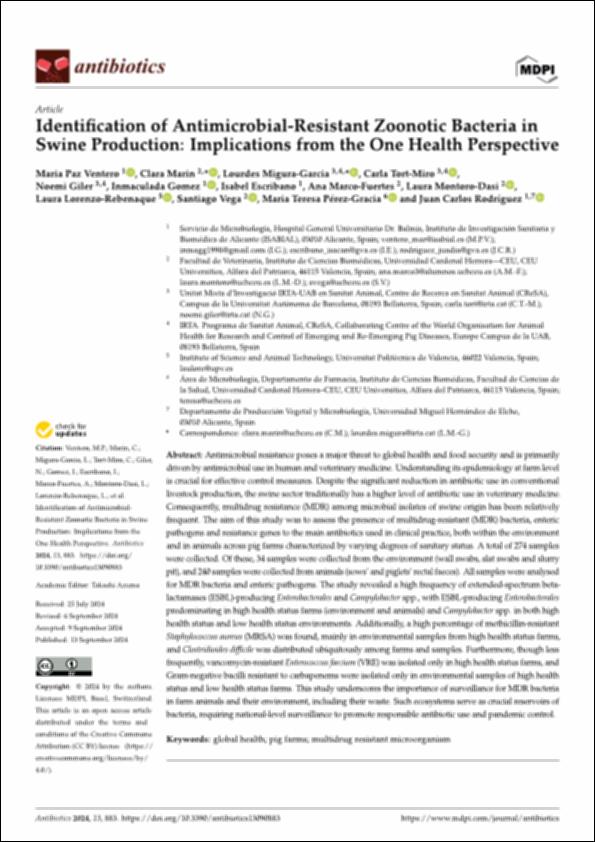Please use this identifier to cite or link to this item:
http://hdl.handle.net/10637/16230Identification of antimicrobial-resistant zoonotic bacteria in swine production: implications from the One Health perspective
| Title: | Identification of antimicrobial-resistant zoonotic bacteria in swine production: implications from the One Health perspective |
| Authors : | Ventero, María Paz Marín Orenga, Clara Migura García, Lourdes Tort Miró, Carla Giler, Noemí Gómez, Inmaculada Escribano, Isabel Marco Fuertes, Ana Montoro Dasí, Laura Lorenzo Rebenaque, Laura Vega García, Santiago Pérez Gracia, María Teresa Rodríguez, Juan Carlos |
| Keywords: | Explotación agrícola; Agricultural holding; Porcino; Swine; Resistencia a los antimicrobianos; Antimicrobial resistance |
| Publisher: | MDPI |
| Citation: | Ventero, M.P., Marin, C., Migura-Garcia, L., Tort-Miro, C., Giler, N., Gomez, I., Escribano, I., Marco-Fuertes, A., Montoro-Dasi, L., Lorenzo-Rebenaque, L., Vega, S., Pérez Gracia, M.T. & Rodríguez, J.C. (2024). Identification of antimicrobial-resistant zoonotic bacteria in swine production: implications from the One Health perspective. Antibiotics, 13, art. 883. https://doi.org/10.3390/antibiotics13090883 |
| Abstract: | Antimicrobial resistance poses a major threat to global health and food security and is primarily driven by antimicrobial use in human and veterinary medicine. Understanding its epidemiology at farm level is crucial for effective control measures. Despite the significant reduction in antibiotic use in conventional livestock production, the swine sector traditionally has a higher level of antibiotic use in veterinary medicine. Consequently, multidrug resistance (MDR) among microbial isolates of swine origin has been relatively frequent. The aim of this study was to assess the presence of multidrug-resistant (MDR) bacteria, enteric pathogens and resistance genes to the main antibiotics used in clinical practice, both within the environment and in animals across pig farms characterized by varying degrees of sanitary status. A total of 274 samples were collected. Of these, 34 samples were collected from the environment (wall swabs, slat swabs and slurry pit), and 240 samples were collected from animals (sows’ and piglets’ rectal faeces). All samples were analysed for MDR bacteria and enteric pathogens. The study revealed a high frequency of extended-spectrum beta-lactamases (ESBL)-producing Enterobacterales and Campylobacter spp., with ESBL-producing Enterobacterales predominating in high health status farms (environment and animals) and Campylobacter spp. in both high health status and low health status environments. Additionally, a high percentage of methicillin-resistant Staphylococcus aureus (MRSA) was found, mainly in environmental samples from high health status farms, and Clostridioides difficile was distributed ubiquitously among farms and samples. Furthermore, though less frequently, vancomycin-resistant Enterococcus faecium (VRE) was isolated only in high health status farms, and Gram-negative bacilli resistant to carbapenems were isolated only in environmental samples of high health status and low health status farms. This study underscores the importance of surveillance for MDR bacteria in farm animals and their environment, including their waste. Such ecosystems serve as crucial reservoirs of bacteria, requiring national-level surveillance to promote responsible antibiotic use and pandemic control. |
| URI: | http://hdl.handle.net/10637/16230 |
| Rights : | http://creativecommons.org/licenses/by/4.0/deed.es Open Access |
| ISSN: | 2079-6382 (Electrónico) |
| Supported by: | Acuerdo Transformativo – 2024 |
| Issue Date: | 13-Sep-2024 |
| Center : | Universidad Cardenal Herrera-CEU |
| Appears in Collections: | Dpto. Producción y Sanidad Animal, Salud Pública Veterinaria y Ciencia y Tecnología de los Alimentos |
Items in DSpace are protected by copyright, with all rights reserved, unless otherwise indicated.


